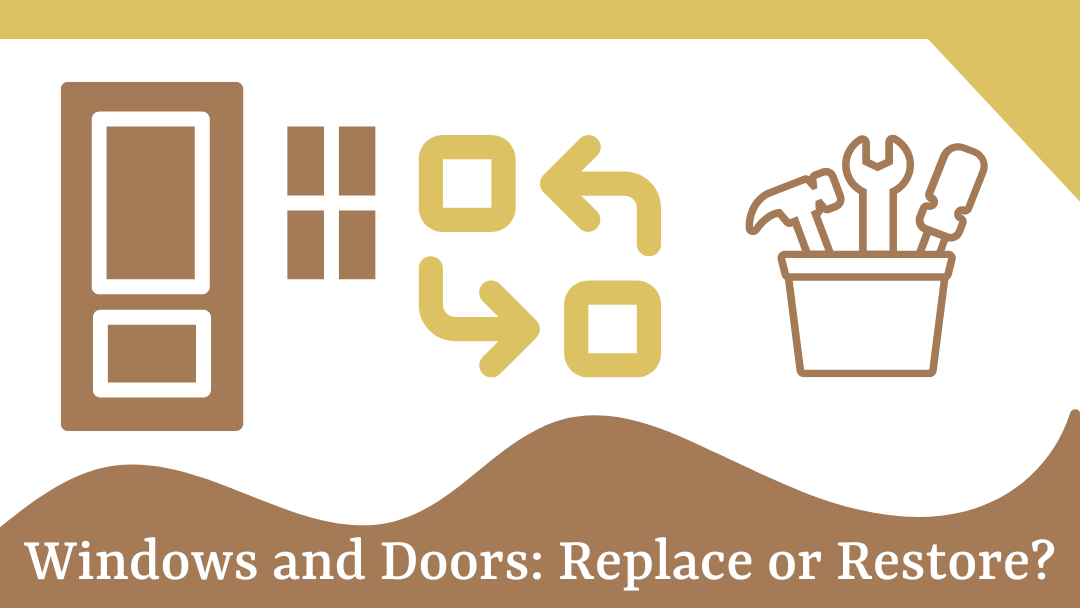Let’s start this discussion by defining an important term that most people aren’t familiar with. Fenestration refers to the design, arrangement, and placement of windows, doors, and other openings in a building’s facade. Fenestration plays a crucial role in every building’s energy efficiency and aesthetic appeal.
The term “fenestration” is derived from the Latin word “fenestra,” which means “opening.” Fenestration can also include other features such as skylights, louvers, and curtain walls. Well designed fenestration can offer ventilation, natural lighting, and beautiful views, while poorly designed fenestration can lead to heat gain or loss, glare, and occupant discomfort.
So, who wouldn’t want a more comfortable and energy efficient home? It turns out that updating windows and doors in an older home to improve both the energy efficiency of the building and the health of the interior environment is one of the top infrastructure projects I recommend to my clients. By better sealing the house envelope, homeowners can reduce their carbon footprint and save money on energy bills.
However, it’s important to recognize that the manufacturing and transportation of these new materials can also have a negative impact on the environment. In order to demystify this surprisingly complex and controversial topic, I want to consider the tradeoffs of updating versus replacing windows and doors in older homes and provide some best practices for reducing carbon emissions while securing the building envelope in a cost-effective manner.
Environmental Impacts of Replacing Windows and Doors
Part of the reason that this topic is confusing is because replacing old doors and windows can have both positive and negative environmental impacts. On the positive side, energy-efficient windows and doors can reduce the amount of energy needed to heat and cool a home, leading to lower carbon emissions and other environmental benefits. However, the production, transportation, and disposal of new windows and doors can also have negative environmental impacts.
The creation of fenestrations involves the extraction and processing of raw materials such as glass, aluminum, and vinyl, which can have significant environmental impacts such as habitat destruction, water pollution, and greenhouse gas emissions. Additionally, the transportation of these materials and finished products can also contribute to carbon emissions and other pollutants.
Another thing many people aren’t aware of is the comparatively high failure rate of modern dual-paned windows. Dual pane windows eventually encounter leaks in the seal that attaches the window to the framing which results in condensation between the two windows. Not only does this create cloudiness in the window, but also reduces the effectiveness of the insulating properties. Also, dual pane windows are only rated for a lifetime of 10-20 years whereas many older, single-pane windows are still performing well more than 100 years after installation.
The disposal of old windows and doors can also have environmental consequences. If not properly recycled or disposed of, these materials can contribute to landfill waste and the release of harmful substances such as lead, which can leach into groundwater and soil.
It is worth noting that some manufacturers now offer recycling and sustainability initiatives to reduce the environmental impact of new windows and doors. For example, some manufacturers use recycled materials or offer take-back programs to recycle old windows and doors. Other producers are adopting more sustainable production practices, such as using renewable energy sources or reducing water usage.
So while energy-efficient windows and doors can lead to lower energy consumption and greenhouse gas emissions, the production, transportation, and disposal of these products can also contribute to environmental degradation. It’s important for homeowners to carefully consider the environmental impact of window and door replacement and choose products and manufacturers that prioritize sustainability and environmental responsibility. And there is always an alternative approach: Restoration.
Historic Window Restoration
Restoring windows is an important consideration when addressing envelop efficiency in any home. As many of you know, I’m a dedicated preservationist. Historic windows not only contribute to the aesthetic of the home, but they are often made of high-quality materials that are more durable and energy-efficient than modern technologies. In addition, historic windows are often an important aspect of the home’s history and may be protected by local historic preservation laws.
When considering window replacement in a historic home, it is important to consult with a professional who has experience working with historic windows. A historic preservation specialist can evaluate the condition of the windows and provide recommendations for repair or other restoration options. In some cases, historic windows can be repaired and retrofitted with energy-efficient features such as laminated or low-e glass, weather stripping, or storm windows.
If replacement is necessary, it is important to select replacement windows that match the original style and design of the historic windows. This may require custom manufacturing or special orders, but it is important to maintain the historic integrity of the home.
I personally live in a home that is listed on the national historic registry, and I’ve been through this process myself. If you would like to discuss the options or need a recommendation to a qualified door and window vendor with experience in restoring or replacing historic windows, I’d love to help you.
Advantages of Maintaining Historic Windows
While the window industry would like you to think that purchasing new windows is always preferable to renovating historic windows, there are substantial financial and environmental benefits to maintaining the condition of older windows:
- Older windows are more reliable. Dual pane windows often fail meaning they get water condensation in the air gap between the sandwiched window panes which necessitates replacement.
- New windows have a large single sheet of glass instead of small pieces of glass that can easily be replaced if needed. In new windows, the entire window needs to be replaced if there is a crack or other seal failure.
- Maintaining historic windows is more cost effective. Considering the high failure rate of dual pane windows it will take several hundred years to recoup the expense based on energy savings.
- Older windows are constructed from old growth hardwood like redwood which makes them impervious to pest infestation if maintained. Broken sash cords can easily be repaired and the glass reglazed.
- Restoring historic windows allows the house to be easily identifiable and in harmony with the original architecture.
Best Practices for Reducing Carbon Emissions
Regardless of the age of your home or whether it has any historic architectural details, there are several best practices all homeowners should follow when it comes to windows and doors. To reduce the carbon emissions associated with updating fenestrations while also securing the building envelope in a cost-effective manner, consider the following options:
- Choose Energy-Efficient Materials: Look for windows and doors that are ENERGY STAR® certified, as these products have been independently tested and certified to meet energy efficiency standards. Energy-efficient materials not only reduce energy consumption, but they also help to reduce the carbon footprint of the home.
- Proper Installation: Proper installation is critical to ensuring that new windows and doors are energy-efficient and properly sealed. Work with a reputable contractor who can install the windows and doors according to manufacturer specifications to ensure maximum energy efficiency.
- Recycle Old Materials: To reduce the environmental impact of window and door replacement, be sure to recycle old materials whenever possible. Many window and door manufacturers have recycling programs in place to ensure that old materials are properly disposed of and reused. Ask questions of your vendor to ensure they offer recycling!
- Use Low-E Coatings: Low-emissivity (Low-E) coatings on window glass can help to reduce heat transfer and improve energy efficiency. This coating reflects heat back into the home during the winter months and reflects heat out of the home during the summer months, reducing the need for heating and cooling.
- Seal Air Leaks: Air leaks around windows and doors can significantly reduce energy efficiency, causing higher energy bills and increasing the carbon footprint of the home. Sometimes just sealing air leaks around existing windows and doors is enough to ensure maximum energy efficiency.
- Reuse or Upcycle When Possible: Reuse is the best first option when removing historic windows. Make sure old windows actually arrive at the local salvage facility. Urban Ore is a great local option. Recycling is the second best option.
Conclusion
Improving the condition of windows and doors in an older home can have a significant impact on both the energy efficiency of the building and the environment. While new windows may seem like an attractive option, renovating older windows will avoid a host of issues, cost less money over they long-term, and retain the architectural character of one of your home’s key features.
By following best practices for restoration and reducing carbon emissions, homeowners can secure the building envelope in a cost-effective manner and improve indoor air quality and comfort. You also have the added benefit of knowing you are doing your best to reduce your carbon footprint and helping to mitigate the effects of climate change.
Book a time to speak with me for a complimentary consultation on your particular situation. I can provide you with advice and specific vendor referrals to meet your needs. I look forward to hearing from you soon!




